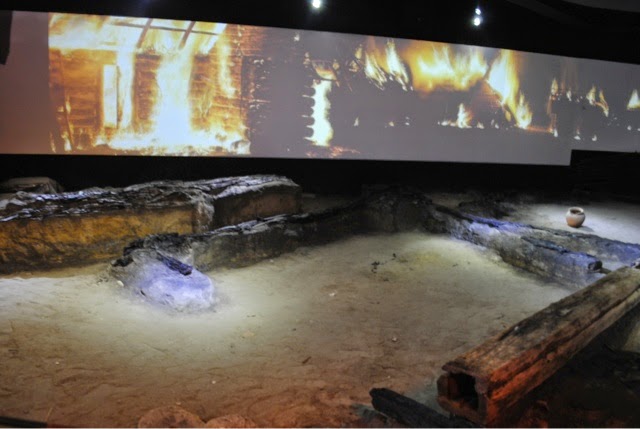The exhibit shows you several times proof of the different layers of civilization found below the current cloth hall. These layers represent civilizations over several centuries. You can see distinctive layers thanks to different kinds of roads made of cobblestones, smooth stone surfaces or wood.
These layers dated from the 12th-14th centuries and thus showed civilizations that were from that time period.
In medieval times Cracow was in the middle of a huge trade network. Goods would pass through Cracow, coming from other cities and often moving on to other locations. Some goods from elsewhere would end up staying in Cracow, but most moved on. Cracow made its money through trade in salt from the Wieliczka salt mine and through charging tolls on the trade routes running through Cracow.
Medieval trade routes going through Cracow. Various routes color-coded.
Texts about trade routes and tolls.
Here is text about the early cloth hall stalls used to trade goods. Bolesław Wstydliwy established the first stalls (Kramy Bolesławowe). Later those stalls were replaced by the "Rich Stalls" (Kramy Bogate) where luxury goods were sold.
Settlements emerged around the cloth hall trading center. Here is some text about that. Read the last sentence carefully. Some poor fellow (prince) could not manage without his beer.
The settlement later burned down and was not rebuilt.
Here is a mock-up of a cabin. All that is remaining is the floor, part of the wall and a dug out wooden log to transport water.
Found around the area of the cloth hall were several graveyards of various sizes. Here is a picture of their locations, marked with the orange colored spots.
The Cloth Hall in the middle of the square was surrounded by graveyards. Smaller graveyards are spread out around it.
If someone was a little odd, he/she might be labeled as a vampire. That meant the burial position was different than a normal person. It could be that the person was buried lying on his side or stomach, sometimes with hands and legs bound with rope. The person could be in the fetal position and perhaps decapitated. Here is a text about it.
If it was determined that such a person (vampire) had not been properly buried (in the correct body position), then the person was dug up and re-buried in the vampire position.
The bodies were consistently buried in an east-west orientation with the heads facing west.
A "vampire", for sure.
A body of a "normal" person would be buried stretched out with their arms at their sides or crossed at the wrists. Sometimes items were buried with them. Here is a regular burial of a person with an earthen vessel included. The bodies were buried either in coffins or shrouds.
These are mock-ups of the "Rich Stalls". They would sell goods through the windows.
The following are photos from the excavations of the area around the current cloth hall on the main square. The digging started in 2005 and ended in 2010. Note the foundations of stalls in rows outside the cloth hall.
Water tank to the right (large rectangular hole).
I highly recommend watching the various documentaries on Polish history towards the end of the exhibit. They are in chronological order and in Polish with subtitles in English.
























No comments:
Post a Comment